Kajang line
The MRT Kajang line (KGL), previously known as the Sungai Buloh–Kajang line (SBK), is a Mass Rapid Transit (MRT) line servicing the Klang Valley, Malaysia. It is the second fully automated and driverless rail system in the Klang Valley region after the LRT Kelana Jaya Line. Owned by MRT Corp and operated as part of the RapidKL system by Rapid Rail, it forms part of the Klang Valley Integrated Transit System. The line is numbered 9 and coloured green on official transit maps.
| Kajang line | ||||||||||||||||||||||||||||||||||||||||||||||||||||||||||||||||||||||||||||||||||||||||||||||||||||||||||||||||||||||||||||||||||||||||||||||||||||||||||||||||||||||||||||||||||||||||||||||||||||||||||||||||||||||||||||||||||||||||||||||||||||||||||||||||||||||||||||||||||||||||||||||||||||||||||||||||||||||||||||||||||||||||||||||||||||||||||||||||||||||||||||||||||||||||||||||||
|---|---|---|---|---|---|---|---|---|---|---|---|---|---|---|---|---|---|---|---|---|---|---|---|---|---|---|---|---|---|---|---|---|---|---|---|---|---|---|---|---|---|---|---|---|---|---|---|---|---|---|---|---|---|---|---|---|---|---|---|---|---|---|---|---|---|---|---|---|---|---|---|---|---|---|---|---|---|---|---|---|---|---|---|---|---|---|---|---|---|---|---|---|---|---|---|---|---|---|---|---|---|---|---|---|---|---|---|---|---|---|---|---|---|---|---|---|---|---|---|---|---|---|---|---|---|---|---|---|---|---|---|---|---|---|---|---|---|---|---|---|---|---|---|---|---|---|---|---|---|---|---|---|---|---|---|---|---|---|---|---|---|---|---|---|---|---|---|---|---|---|---|---|---|---|---|---|---|---|---|---|---|---|---|---|---|---|---|---|---|---|---|---|---|---|---|---|---|---|---|---|---|---|---|---|---|---|---|---|---|---|---|---|---|---|---|---|---|---|---|---|---|---|---|---|---|---|---|---|---|---|---|---|---|---|---|---|---|---|---|---|---|---|---|---|---|---|---|---|---|---|---|---|---|---|---|---|---|---|---|---|---|---|---|---|---|---|---|---|---|---|---|---|---|---|---|---|---|---|---|---|---|---|---|---|---|---|---|---|---|---|---|---|---|---|---|---|---|---|---|---|---|---|---|---|---|---|---|---|---|---|---|---|---|---|---|---|---|---|---|---|---|---|---|---|---|---|---|---|---|---|---|---|---|---|---|---|---|---|---|---|---|---|---|---|---|---|---|---|---|---|---|---|---|---|---|---|---|---|---|---|---|---|---|---|---|---|---|---|---|---|---|---|---|---|---|---|---|---|---|---|---|---|---|---|
 | ||||||||||||||||||||||||||||||||||||||||||||||||||||||||||||||||||||||||||||||||||||||||||||||||||||||||||||||||||||||||||||||||||||||||||||||||||||||||||||||||||||||||||||||||||||||||||||||||||||||||||||||||||||||||||||||||||||||||||||||||||||||||||||||||||||||||||||||||||||||||||||||||||||||||||||||||||||||||||||||||||||||||||||||||||||||||||||||||||||||||||||||||||||||||||||||||
| Overview | ||||||||||||||||||||||||||||||||||||||||||||||||||||||||||||||||||||||||||||||||||||||||||||||||||||||||||||||||||||||||||||||||||||||||||||||||||||||||||||||||||||||||||||||||||||||||||||||||||||||||||||||||||||||||||||||||||||||||||||||||||||||||||||||||||||||||||||||||||||||||||||||||||||||||||||||||||||||||||||||||||||||||||||||||||||||||||||||||||||||||||||||||||||||||||||||||
| Native name | MRT Laluan Kajang | |||||||||||||||||||||||||||||||||||||||||||||||||||||||||||||||||||||||||||||||||||||||||||||||||||||||||||||||||||||||||||||||||||||||||||||||||||||||||||||||||||||||||||||||||||||||||||||||||||||||||||||||||||||||||||||||||||||||||||||||||||||||||||||||||||||||||||||||||||||||||||||||||||||||||||||||||||||||||||||||||||||||||||||||||||||||||||||||||||||||||||||||||||||||||||||||
| Status | Fully operational | |||||||||||||||||||||||||||||||||||||||||||||||||||||||||||||||||||||||||||||||||||||||||||||||||||||||||||||||||||||||||||||||||||||||||||||||||||||||||||||||||||||||||||||||||||||||||||||||||||||||||||||||||||||||||||||||||||||||||||||||||||||||||||||||||||||||||||||||||||||||||||||||||||||||||||||||||||||||||||||||||||||||||||||||||||||||||||||||||||||||||||||||||||||||||||||||
| Owner | MRT Corp | |||||||||||||||||||||||||||||||||||||||||||||||||||||||||||||||||||||||||||||||||||||||||||||||||||||||||||||||||||||||||||||||||||||||||||||||||||||||||||||||||||||||||||||||||||||||||||||||||||||||||||||||||||||||||||||||||||||||||||||||||||||||||||||||||||||||||||||||||||||||||||||||||||||||||||||||||||||||||||||||||||||||||||||||||||||||||||||||||||||||||||||||||||||||||||||||
| Line number | 9 (green) | |||||||||||||||||||||||||||||||||||||||||||||||||||||||||||||||||||||||||||||||||||||||||||||||||||||||||||||||||||||||||||||||||||||||||||||||||||||||||||||||||||||||||||||||||||||||||||||||||||||||||||||||||||||||||||||||||||||||||||||||||||||||||||||||||||||||||||||||||||||||||||||||||||||||||||||||||||||||||||||||||||||||||||||||||||||||||||||||||||||||||||||||||||||||||||||||
| Locale | Klang Valley | |||||||||||||||||||||||||||||||||||||||||||||||||||||||||||||||||||||||||||||||||||||||||||||||||||||||||||||||||||||||||||||||||||||||||||||||||||||||||||||||||||||||||||||||||||||||||||||||||||||||||||||||||||||||||||||||||||||||||||||||||||||||||||||||||||||||||||||||||||||||||||||||||||||||||||||||||||||||||||||||||||||||||||||||||||||||||||||||||||||||||||||||||||||||||||||||
| Termini |
| |||||||||||||||||||||||||||||||||||||||||||||||||||||||||||||||||||||||||||||||||||||||||||||||||||||||||||||||||||||||||||||||||||||||||||||||||||||||||||||||||||||||||||||||||||||||||||||||||||||||||||||||||||||||||||||||||||||||||||||||||||||||||||||||||||||||||||||||||||||||||||||||||||||||||||||||||||||||||||||||||||||||||||||||||||||||||||||||||||||||||||||||||||||||||||||||
| Stations | 29 & 3 reserved | |||||||||||||||||||||||||||||||||||||||||||||||||||||||||||||||||||||||||||||||||||||||||||||||||||||||||||||||||||||||||||||||||||||||||||||||||||||||||||||||||||||||||||||||||||||||||||||||||||||||||||||||||||||||||||||||||||||||||||||||||||||||||||||||||||||||||||||||||||||||||||||||||||||||||||||||||||||||||||||||||||||||||||||||||||||||||||||||||||||||||||||||||||||||||||||||
| Website | myrapid | |||||||||||||||||||||||||||||||||||||||||||||||||||||||||||||||||||||||||||||||||||||||||||||||||||||||||||||||||||||||||||||||||||||||||||||||||||||||||||||||||||||||||||||||||||||||||||||||||||||||||||||||||||||||||||||||||||||||||||||||||||||||||||||||||||||||||||||||||||||||||||||||||||||||||||||||||||||||||||||||||||||||||||||||||||||||||||||||||||||||||||||||||||||||||||||||
| Service | ||||||||||||||||||||||||||||||||||||||||||||||||||||||||||||||||||||||||||||||||||||||||||||||||||||||||||||||||||||||||||||||||||||||||||||||||||||||||||||||||||||||||||||||||||||||||||||||||||||||||||||||||||||||||||||||||||||||||||||||||||||||||||||||||||||||||||||||||||||||||||||||||||||||||||||||||||||||||||||||||||||||||||||||||||||||||||||||||||||||||||||||||||||||||||||||||
| Type | Rapid transit | |||||||||||||||||||||||||||||||||||||||||||||||||||||||||||||||||||||||||||||||||||||||||||||||||||||||||||||||||||||||||||||||||||||||||||||||||||||||||||||||||||||||||||||||||||||||||||||||||||||||||||||||||||||||||||||||||||||||||||||||||||||||||||||||||||||||||||||||||||||||||||||||||||||||||||||||||||||||||||||||||||||||||||||||||||||||||||||||||||||||||||||||||||||||||||||||
| System | ||||||||||||||||||||||||||||||||||||||||||||||||||||||||||||||||||||||||||||||||||||||||||||||||||||||||||||||||||||||||||||||||||||||||||||||||||||||||||||||||||||||||||||||||||||||||||||||||||||||||||||||||||||||||||||||||||||||||||||||||||||||||||||||||||||||||||||||||||||||||||||||||||||||||||||||||||||||||||||||||||||||||||||||||||||||||||||||||||||||||||||||||||||||||||||||||
| Services | Kwasa Damansara–Kajang | |||||||||||||||||||||||||||||||||||||||||||||||||||||||||||||||||||||||||||||||||||||||||||||||||||||||||||||||||||||||||||||||||||||||||||||||||||||||||||||||||||||||||||||||||||||||||||||||||||||||||||||||||||||||||||||||||||||||||||||||||||||||||||||||||||||||||||||||||||||||||||||||||||||||||||||||||||||||||||||||||||||||||||||||||||||||||||||||||||||||||||||||||||||||||||||||
| Operator(s) | Rapid Rail | |||||||||||||||||||||||||||||||||||||||||||||||||||||||||||||||||||||||||||||||||||||||||||||||||||||||||||||||||||||||||||||||||||||||||||||||||||||||||||||||||||||||||||||||||||||||||||||||||||||||||||||||||||||||||||||||||||||||||||||||||||||||||||||||||||||||||||||||||||||||||||||||||||||||||||||||||||||||||||||||||||||||||||||||||||||||||||||||||||||||||||||||||||||||||||||||
| Depot(s) | Sungai Buloh Depot and Kajang Depot | |||||||||||||||||||||||||||||||||||||||||||||||||||||||||||||||||||||||||||||||||||||||||||||||||||||||||||||||||||||||||||||||||||||||||||||||||||||||||||||||||||||||||||||||||||||||||||||||||||||||||||||||||||||||||||||||||||||||||||||||||||||||||||||||||||||||||||||||||||||||||||||||||||||||||||||||||||||||||||||||||||||||||||||||||||||||||||||||||||||||||||||||||||||||||||||||
| Rolling stock | Siemens Inspiro 58 four-car trainsets Width: 3.1 m (10 ft) - wide profile Length: 90.18 m (295.9 ft)[1] | |||||||||||||||||||||||||||||||||||||||||||||||||||||||||||||||||||||||||||||||||||||||||||||||||||||||||||||||||||||||||||||||||||||||||||||||||||||||||||||||||||||||||||||||||||||||||||||||||||||||||||||||||||||||||||||||||||||||||||||||||||||||||||||||||||||||||||||||||||||||||||||||||||||||||||||||||||||||||||||||||||||||||||||||||||||||||||||||||||||||||||||||||||||||||||||||
| Daily ridership | 215,853 (2019; Highest)[2] | |||||||||||||||||||||||||||||||||||||||||||||||||||||||||||||||||||||||||||||||||||||||||||||||||||||||||||||||||||||||||||||||||||||||||||||||||||||||||||||||||||||||||||||||||||||||||||||||||||||||||||||||||||||||||||||||||||||||||||||||||||||||||||||||||||||||||||||||||||||||||||||||||||||||||||||||||||||||||||||||||||||||||||||||||||||||||||||||||||||||||||||||||||||||||||||||
| Ridership | 45.36 million (2022) 63.95 million (2019; Highest) | |||||||||||||||||||||||||||||||||||||||||||||||||||||||||||||||||||||||||||||||||||||||||||||||||||||||||||||||||||||||||||||||||||||||||||||||||||||||||||||||||||||||||||||||||||||||||||||||||||||||||||||||||||||||||||||||||||||||||||||||||||||||||||||||||||||||||||||||||||||||||||||||||||||||||||||||||||||||||||||||||||||||||||||||||||||||||||||||||||||||||||||||||||||||||||||||
| History | ||||||||||||||||||||||||||||||||||||||||||||||||||||||||||||||||||||||||||||||||||||||||||||||||||||||||||||||||||||||||||||||||||||||||||||||||||||||||||||||||||||||||||||||||||||||||||||||||||||||||||||||||||||||||||||||||||||||||||||||||||||||||||||||||||||||||||||||||||||||||||||||||||||||||||||||||||||||||||||||||||||||||||||||||||||||||||||||||||||||||||||||||||||||||||||||||
| Opened | Phase 1: 16 December 2016[3] Sungai Buloh SBK01 (the terminus station is currently Kwasa Damansara) KG04 – Semantan KG14 Phase 2: 17 July 2017 Muzium Negara KG15 – Kajang KG31 | |||||||||||||||||||||||||||||||||||||||||||||||||||||||||||||||||||||||||||||||||||||||||||||||||||||||||||||||||||||||||||||||||||||||||||||||||||||||||||||||||||||||||||||||||||||||||||||||||||||||||||||||||||||||||||||||||||||||||||||||||||||||||||||||||||||||||||||||||||||||||||||||||||||||||||||||||||||||||||||||||||||||||||||||||||||||||||||||||||||||||||||||||||||||||||||||
| Technical | ||||||||||||||||||||||||||||||||||||||||||||||||||||||||||||||||||||||||||||||||||||||||||||||||||||||||||||||||||||||||||||||||||||||||||||||||||||||||||||||||||||||||||||||||||||||||||||||||||||||||||||||||||||||||||||||||||||||||||||||||||||||||||||||||||||||||||||||||||||||||||||||||||||||||||||||||||||||||||||||||||||||||||||||||||||||||||||||||||||||||||||||||||||||||||||||||
| Line length | 47 km (29 mi) Elevated: 37.5 km (23.3 mi) Underground: 9.5 km (5.9 mi) | |||||||||||||||||||||||||||||||||||||||||||||||||||||||||||||||||||||||||||||||||||||||||||||||||||||||||||||||||||||||||||||||||||||||||||||||||||||||||||||||||||||||||||||||||||||||||||||||||||||||||||||||||||||||||||||||||||||||||||||||||||||||||||||||||||||||||||||||||||||||||||||||||||||||||||||||||||||||||||||||||||||||||||||||||||||||||||||||||||||||||||||||||||||||||||||||
| Track gauge | 1,435 mm (4 ft 8+1⁄2 in) standard gauge | |||||||||||||||||||||||||||||||||||||||||||||||||||||||||||||||||||||||||||||||||||||||||||||||||||||||||||||||||||||||||||||||||||||||||||||||||||||||||||||||||||||||||||||||||||||||||||||||||||||||||||||||||||||||||||||||||||||||||||||||||||||||||||||||||||||||||||||||||||||||||||||||||||||||||||||||||||||||||||||||||||||||||||||||||||||||||||||||||||||||||||||||||||||||||||||||
| Electrification | 750 V DC third rail | |||||||||||||||||||||||||||||||||||||||||||||||||||||||||||||||||||||||||||||||||||||||||||||||||||||||||||||||||||||||||||||||||||||||||||||||||||||||||||||||||||||||||||||||||||||||||||||||||||||||||||||||||||||||||||||||||||||||||||||||||||||||||||||||||||||||||||||||||||||||||||||||||||||||||||||||||||||||||||||||||||||||||||||||||||||||||||||||||||||||||||||||||||||||||||||||
| Conduction system | Automated and driverless | |||||||||||||||||||||||||||||||||||||||||||||||||||||||||||||||||||||||||||||||||||||||||||||||||||||||||||||||||||||||||||||||||||||||||||||||||||||||||||||||||||||||||||||||||||||||||||||||||||||||||||||||||||||||||||||||||||||||||||||||||||||||||||||||||||||||||||||||||||||||||||||||||||||||||||||||||||||||||||||||||||||||||||||||||||||||||||||||||||||||||||||||||||||||||||||||
| Operating speed | 100 km/h (62 mph) | |||||||||||||||||||||||||||||||||||||||||||||||||||||||||||||||||||||||||||||||||||||||||||||||||||||||||||||||||||||||||||||||||||||||||||||||||||||||||||||||||||||||||||||||||||||||||||||||||||||||||||||||||||||||||||||||||||||||||||||||||||||||||||||||||||||||||||||||||||||||||||||||||||||||||||||||||||||||||||||||||||||||||||||||||||||||||||||||||||||||||||||||||||||||||||||||
| ||||||||||||||||||||||||||||||||||||||||||||||||||||||||||||||||||||||||||||||||||||||||||||||||||||||||||||||||||||||||||||||||||||||||||||||||||||||||||||||||||||||||||||||||||||||||||||||||||||||||||||||||||||||||||||||||||||||||||||||||||||||||||||||||||||||||||||||||||||||||||||||||||||||||||||||||||||||||||||||||||||||||||||||||||||||||||||||||||||||||||||||||||||||||||||||||

It is one of three planned MRT rail lines under the Klang Valley Mass Rapid Transit Project by MRT Corp. Phase 1 operations between Sungai Buloh and Semantan commenced service on 16 December 2016.[4] Phase 2 operations between Muzium Negara and Kajang was opened on 17 July 2017, as a free shuttle service, by former Malaysian Prime Minister, Dato' Seri Najib Tun Razak in a ceremony at the Tun Razak Exchange station. Full revenue service between Sungai Buloh and Kajang began the following day.[5][6][7]
History
Initial LRT proposal
In August 2006, the LRT Kota Damansara–Cheras line proposal was first made known to the public by the then deputy Prime Minister, Datuk Seri Najib Tun Razak under a RM10 billion government allocation for the improvement and expansion of the public transportation network in the Klang Valley as a new light rapid transit (LRT) system. The line is also targeted to alleviate traffic congestion in the Klang Valley by encouraging more commuters to opt for public transport.[note 1] It is also aimed to reduce overcrowding on the KL Monorail and to provide an alternative transport mode due to rising fuel prices.[9] It is estimated to be approximately 30 km (19 mi) in length.[8] This is planned in-line with the extension of the LRT Kelana Jaya Line and the LRT Sri Petaling Line, to Subang Jaya and Puchong respectively and converging at Putra Heights.[9] The combined cost of the new line and the proposed extensions were estimated at RM7 billion. Syarikat Prasarana Nasional Berhad (SPNB) was in charge of the construction of these lines. The line was planned to be served by 140 coaches, and the track gauge to be almost similar to existing LRT lines.[10] The Ministry of Transport had approved the alignment of the new line in July 2007 which would then be tabled to the Cabinet for approval.[11] The Finance Ministry's Parliamentary Secretary announced that the line from Kota Damansara to Cheras and Balakong would be completed by 2012.[12] The line would be 40 km (25 mi) long, serving densely populated areas in Damansara and Cheras via "The Golden Triangle" of Kuala Lumpur city.[note 2] The alignment was to be from Persiaran Surian to the Balakong Interchange on the Cheras-Kajang Expressway, passing through the Damansara-Puchong Expressway (LDP), Sprint Highway, the city, Jalan Tun Razak and Jalan Cheras, stopping at around 30 stations. Ownership of the line belonged to SPNB, and would be operated by Rapid Rail. The estimated construction cost is between RM4 billion and RM5 billion.[9]
In September 2008, Executive Director of SPNB said that a 5.9 km (3.7 mi) section of the line in central Kuala Lumpur will be underground, serving 5 stations. However, the locations of underground stations were not announced. It was during this time that the line was said to be 42 km (26 mi) with 32 stations in total, which would serve areas of Bandar Utama, Bangsar, KL Sentral, Bukit Bintang, Bandar Tasik Selatan and Cheras. The line was being considered for as a Mass Rapid Transit (MRT) system after taking into consideration the catchment area serving a population of 878,000. It was also reported that the detailed design stage for the line would commence in the second quarter of 2009 and the opening date is expected to be in 2014.[14][note 3]
New alignment and conversion to MRT
On 14 September 2009, SPNB managing director Datuk Idrose Mohamed was reported as saying that the new line could end up longer than the earlier announced alignment although he did not offer any further details. A public display of the alignment was launched a day after the announcement. SPNB has raised the necessary funds from Islamic investments of RM2 billion and hopes to gain approval from the Ministry of Transport to call out for tenders.[16] In April 2010, a proposal to extend the line by 16 km (9.9 mi) was being studied by the government.[note 4] The proposal includes extensions from Kota Damansara to Sungai Buloh (additional 3 km (1.9 mi)) and from Cheras to Kajang (additional 9 km (5.6 mi)). This is to provide convenient interchanges to the existing Keretapi Tanah Melayu (KTM) stations at Sungai Buloh and Kajang, as well as supporting the upcoming development of some 3,000-acre (1,200 ha) land in Sungai Buloh. An additional branch line from Damansara Utama to Kelana Jaya (additional 4 km (2.5 mi)) aimed to relieve congestion on the LDP Highway was also being studied, bringing the total length of the line to 59 km (37 mi).[17]
Unofficial statements in 2009 claimed that the proposed line was changed to an MRT line.[18] In June 2010, during the tabling of the 10th Malaysia Plan, [19] Prime Minister Najib Tun Razak announced that the government was now considering a RM36 billion Klang Valley MRT proposal from Gamuda Berhad and MMC Corporation Berhad, which is the largest national infrastructure project.[20] The proposal includes 3 lines, including one which is similar to the Kota Damansara—Cheras proposal.[note 5] The MRT lines were to be mostly underground with stations 500 m (1,600 ft) to 1 km (3,300 ft) apart in areas with high demand. The concept was envisioned to be inspired by Singapore's Mass Rapid Transit (MRT) system.[21][22][note 6] The project, aimed to improve public transport in the Klang Valley, was approved by the Malaysian cabinet on 16 December 2010 and construction of the first line from Sungai Buloh to Kajang would begin in July 2011 with a duration of five to six years.[23] Gross national income from these future lines is between RM3 bil and RM12 bil. The government had appointed MMC-Gamuda JV Sdn Bhd as Project Delivery Partner where it would play the role project manager, supervised by the Land Public Transport Commission (SPAD). The whole project would be divided into nine parcels in which will be done on open tender basis. 10 km (6.2 mi) of the line would be underground and the remaining 50 km (31 mi) above ground with 35 new stations. MMC-Gamuda would be barred from bidding for any tender except for tunnelling works (the most expensive portion). Ownership of the lines would be given to SPNB.[24][25]
To seek for further consultation from the public, SPAD held a 3-month public display of the alignment of the MRT Kajang Line.[26] On 8 July 2011, Razak officially launched the project. The final alignment was adjusted following the public display, having a length of 51 km (32 mi) with 31 stations where 16 have Park and Ride facilities. Construction was said to be completed in December 2016 and the line would start operations a month after.[27] On 17 August 2011, the government announced that Mass Rapid Transit Corporation Sdn Bhd (MRT Corp), a new company under the Finance Ministry had been formed to take control of the project from Prasarana. MRT Corp would be the asset owner of the project and officially take over the project from Prasarana on 1 September 2011.[28] After the MRT project was formally launched on 8 July 2011, the following amendments have been made to the original proposed alignment following the public display exercise between March and May 2011:[27][29]
- 31 stations instead of 35 stations will be built and provisions have been made for 3 more stations
- Future station 1 (Teknologi) located between Kwasa Sentral and Kota Damansara stations
- Future station 2 (Bukit Kiara) located between Phileo Damansara and Pusat Bandar Damansara stations
- Construction of Taman Mesra station has been shelved.
- The proposed Section 17 station was dropped
- The location of the proposed TTDI station was moved around 300 m (980 ft) southwards to the former Caltex petrol stations. This was due to complaints from Taman Tun Dr Ismail and Damansara Kim residents.[30][31][32][33]
- Bukit Bintang East and West stations have been combined into one, moved and integrated with KL Monorail station. The station was named Bukit Bintang Central Station and subsequently Bukit Bintang Station.
- Park-and-ride facilities has been increased to 16 from 13 previously.
- Adjustments to the alignment:
- Shifting alignment into the former Rubber Research Institute of Malaysia land in Sungai Buloh to cater for future development
- Adjusting the alignment adjacent to Bandar Kajang station to avoid going through the town centre and through Kajang Stadium.
Contract allocation
On 21 October 2011, MRT Corp shortlisted 5 companies to construct the underground parts of the line including MMC Gamuda Joint Venture and Sinohydro Group.[34] On 26 January 2012, MRT Corp announced the award of the first two civil works contracts for the construction of the MRT Kajang line. IJM Construction Sdn Bhd was appointed the contractor for Package V5 at a tender price of RM974 million, while Ahmad Zaki Sdn Bhd was appointed the contractor for Package V6 at a tender price of RM764 million. Package V5 is from the Maluri portal to Plaza Phoenix (now Taman Connaught) station while Package V6 covers the section between Plaza Phoenix and Bandar Tun Hussein Onn stations.[35] MRT Corp announced the pre-qualification of 28 companies to bid for six System Works Packages for the MRT line on 8 March 2012.[36] Subsequently, in September 2012, another 31 companies were pre-qualified to bid for the remaining five System Works Packages.[37][38]
Construction

All stations are to be equipped with platform screen doors, where this contract was awarded to the Singaporean company Singapore Technology Electronics Ltd.[39] 33kV Main Switching Substations are to be constructed at 4 stations, namely Taman Industri Sungai Buloh (now Kwasa Sentral), Section 16 (now Phileo Damansara), Taman Cuepacs (now Sri Raya) and Kajang stations. The other 3 substations are added at the Cochrane launch shaft, Sungai Buloh depot and Semantan portal. Two more 132/33kV Transmission Main Intakes are constructed at Cochrane Launch shaft and Semantan portal. Tenaga Nasional Berhad (TNB) agreed to supply 116.5MW of power on the Kajang Line which costs RM173.1 million.[40]
On 1 November 2011, the 70's Klang bus stand ceased operations and was demolished to make way for the underground platforms and new entrances of Pasar Seni station. When construction of the station is completed, a new bus hub will be reconstructed.[41] On 1 August 2012, MRT Corp announced that the project was in active construction phase.[32] MRT Corp said that the project cost would not exceed the limit of RM23 billion. The first section between Sungai Buloh and Semantan was expected to open in December 2016, with the entire line opening in July 2017.[42]
On 30 May 2013, tunnel excavation works for the Kajang Line began with the world's first Variable Density Tunnel Boring Machine (VDTBM). This TBM was jointly designed by MMC Gamuda KVMRT Tunnelling and Herrenknecht AG, a German company. Commencement of tunnelling works was launched by former Malaysian Prime Minister Najib Tun Razak at the Cochrane Launch Shaft, which would later become the Cochrane MRT station.[43] The shaft is 30 m (98 ft) deep and this TBM was to dig a distance of 1.2 km (0.75 mi) towards Pasar Rakyat (now Tun Razak Exchange) station. 10 TBMs were used to construct the 9.5 km (5.9 mi) tunnelled section of the line, where 6 are Variable Density and 4 are Earth Pressure Balance TBMs.[44] The tunnels are to have a diameter of 6 m (20 ft), where the first breakthrough of the TBM excavations occurred on 25 December 2013.[45]
Opening
On 2 September 2016, Prime Minister Najib Tun Razak took a surprise visit on the MRT line. He took a return trip from Semantan station to Phileo Damansara station in which he visited the latter.[46]
On 16 December 2016, Phase 1 of the Kajang Line which spans 23 km from opened between Sungai Buloh to Semantan.
The fare of this part of the line and its feeder bus routes was free of charge until 16 January 2017.[47] Two days later, MRT Corp confirms cost of 51 km of Kajang Line would be RM21 billion.[48] On 17 July 2017, Phase Two of the line from Semantan to Kajang began operations.[49]
The line is operated by a subsidiary of Prasarana Malaysia, Rapid Rail, which already operates the Ampang Line, Sri Petaling Line, Kelana Jaya Line and KL Monorail.[50]
Overview
Route
_Upper_Platform_(220724)_2.jpg.webp)
The MRT line covers a span of 47 kilometres (29 mi) from Kwasa Damansara to Kajang, passing the Kuala Lumpur city centre where the alignment goes underground. The line serves a corridor with 1.2 million residents within the Klang Valley region from the northwest to the southeast of Kuala Lumpur. The line starts from Kwasa Damansara which is located to the northwest of Kuala Lumpur, and runs on an elevated guideway to the Semantan portal, passing through Kota Damansara, Bandar Utama, Seksyen 17 Petaling Jaya, Phileo Damansara and Damansara Town Centre. Kwasa Damansara provides a cross-platform interchange between the MRT Kajang Line and the MRT Putrajaya Line. The line continues in twin-bore tunnels underground to the Maluri portal, passing through the city centre and the Golden Triangle of Kuala Lumpur. Interchanges to other lines are provided from Muzium Negara to Maluri with the exception of Cochrane station in Kuala Lumpur. Beyond Taman Pertama, the line passes through Cheras and ends in Kajang via an elevated guideway. [20][51]
Station designs
_Exterior_(220717)_3.jpg.webp)
For the seven underground stations, the overall inspiration was from the Klang Gates Quartz Ridge, a pure quartz dyke found in the Klang Valley which has multi-faceted characteristics and has kaleidoscopic reflections. These features resemble Malaysia's multi-racial, multi-cultural and progressive society.[52] The concept is used in the designs of the different murals in the underground stations. Muzium Negara is fitted with tiles that depict the transition of the city's mode of public transport while Pasar Seni is "painted" with 'Y's, which represents the convergence of the Klang and Gombak rivers. Merdeka has the Rukun Negara sculpted on the walls of the concourse. Tun Razak Exchange has designs of blue and grey motives representing a modern Islamic Corporate theme. Cochrane features harmonious red and yellow colours while Bukit Bintang has vibrant red patterns. Maluri is filled with bright green, blue and yellow tiles which symbolises urban renewal.[52][53]
All stations are wheelchair accessible, with lifts and escalators serving each platform.[52] All platforms are equipped with platform screen doors.[39]
List of stations
| Station Code | Station Name | Image | Opened | Position | Park & Ride | Connecting Bus Lines | Working Name | Interchange/Notes |
| KG04 | Kwasa Damansara |  | 16 December 2016 | Elevated | ✓ | N/A | Kota Damansara | Northern terminus of both the MRT Kajang Line and MRT Putrajaya Line.
Cross-platform interchange with PY01 MRT Putrajaya Line |
| KG05 | Kwasa Sentral | _Exterior_(220724)_2.jpg.webp) |
✓ | 5 lines | Taman Industri Sungai Buloh | Feeder Bus | ||
| KG05A | Teknologi | _Proposed_Location_(220724)_2.jpg.webp) | - | - | - | - | - | Provisional station[27] |
| KG06 | Kota Damansara |  | 16 December 2016 | Elevated | N/A | 2 lines | PJU 5 | |
| KG07 | Surian | _Exterior_(220828)_1.jpg.webp) |
N/A | 4 lines | Dataran Sunway | Feeder Bus | ||
| KG08 | Mutiara Damansara | 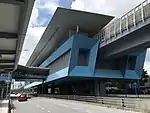 |
N/A | 6 lines | The Curve | |||
| KG09 | Bandar Utama | 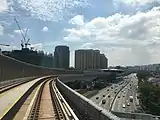 |
✓ | 6 lines | One Utama | Future interchange with the SA01 LRT Shah Alam Line. | ||
| KG10 | Taman Tun Dr Ismail (TTDI) |  |
N/A | 2 lines | TTDI | |||
| KG11 | - | - | - | - | - | - | Shelved station | |
| KG12 | Phileo Damansara | 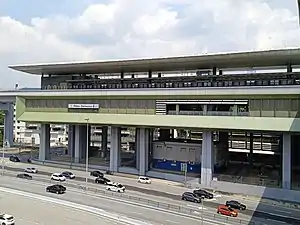 |
16 December 2016 | Elevated | ✓ | 2 lines | Seksyen 16 | Feeder bus |
| KG12A | Bukit Kiara Selatan | _Aerial_View_(220910)_2.jpg.webp) |
- | - | - | - | - | Provisional station.
Proposed interchange with CC01 MRT Circle Line. |
| KG13 | Pavilion Damansara Heights–Pusat Bandar Damansara | 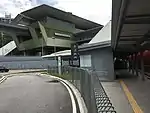 | 16 December 2016 | Elevated | ✓ | 1 lines | Pusat Bandar Damansara | Feeder bus |
| KG14 | Manulife–Semantan | 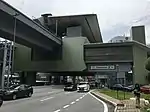 |
N/A | 5 lines | Semantan | Feeder bus | ||
| KG15 | Muzium Negara |  | 17 July 2017 | Underground | N/A | 1 line | KL Sentral | Connecting station to KL Sentral, linked via a 600-meter pedestrian walkway, for:
|
| KG16 | Pasar Seni |  |
13 lines | Pasar Seni | Interchange station with KJ14 LRT Kelana Jaya Line
Connecting station to KA02 Kuala Lumpur for KTM Seremban Line, KTM Port Klang Line and KTM ETS via a pedestrian bridge across the Klang River. Bus hub to Puchong, Subang Airport, Petaling Jaya, Klang, Shah Alam and Subang Jaya.
| |||
| KG17 | Merdeka | 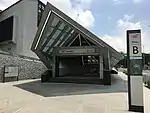 |
N/A | Merdeka | Interchange station with AG8 SP8 Plaza Rakyat for LRT Ampang and Sri Petaling Lines.
| |||
| KG18A | Pavilion Kuala Lumpur–Bukit Bintang |  |
7 lines | Bukit Bintang Sentral | Connecting station to MR6 KL Monorail.
Pedestrian access to KJ10 KLCC on the LRT Kelana Jaya Line and MR7 Raja Chulan for the KL Monorail via an elevated walkway from Pavilion Kuala Lumpur. Theme: Dynamic | |||
| KG20 | Tun Razak Exchange (TRX) |  |
2 lines | Pasar Rakyat | Cross-platform interchange with PY23 MRT Putrajaya Line.
| |||
| KG21 | Cochrane |  |
4 lines | Cochrane | Feeder bus Theme: Urban Living | |||
| KG22 | AEON–Maluri |  |
✓ | 8 lines | Maluri | Interchange station with AG13 for LRT Ampang Line.
Feeder bus Theme: New Generation | ||
| KG23 | Taman Pertama | .jpg.webp) |
Elevated | N/A | 3 lines | Taman Bukit Ria | ||
| KG24 | Taman Midah |  |
✓ | 4 lines[54] | Taman Bukit Mewah |
Feeder bus Proposed interchange with CC22 MRT Circle Line. | ||
| KG25 | Taman Mutiara | 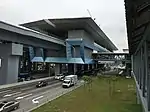 |
N/A | 4 lines | Leisure Mall | |||
| KG26 | Taman Connaught | 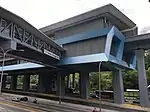 |
N/A | 4 lines | Plaza Phoenix | Feeder bus | ||
| KG27 | Taman Suntex |  |
✓ | 3 lines | Taman Suntex | |||
| KG28 | Sri Raya | 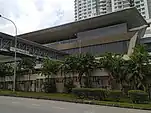 |
3 lines | Taman Cuepacs | ||||
| KG29 | Bandar Tun Hussein Onn |  |
2 line | Bandar Tun Hussein Onn | ||||
| KG30 | Batu 11 Cheras | .jpg.webp) |
N/A | 5 lines | Balakong | |||
| KG31 | Bukit Dukung | _01.jpg.webp) |
✓ | 4 lines |
Taman Koperasi | |||
| KG32 | - | - | - | - | - | - | Shelved station | |
| KG33 | Sungai Jernih | _02.jpg.webp) | 17 July 2017 | Elevated | ✓ | 2 line | Saujana Impian | |
| KG34 | Stadium Kajang | _01.jpg.webp) |
N/A | 8 lines | Bandar Kajang | Feeder bus | ||
| KG35 | Kajang | _01.jpg.webp) |
✓ | 6 lines | Kajang | Southern terminus.
Interchange station, without paid area integration to KB06 KTM Seremban Line and KTM ETS.[55] Proposed interchange with Putrajaya Monorail | ||
Rolling stock
_Platform_Towards_Kwasa_Damansara_(220719)_1.jpg.webp)

According to MRT Corp, the four-car train sets are servicing the line with an average headway of 3.5 minutes in an hour, equivalent to 400,000 passengers per day.[56]
The rolling stock is manufactured by Siemens/CSR Nanjing Puzhen in a partnership with SMH Rail Consortium Sdn Bhd. The trains will be driverless with a capacity of 1,200 passengers in a 4-car trainsets formation. The Siemens Inspiro rolling stock will be supplied with the same configuration as the trainsets supplied for Warsaw Metro M1.[57]
- 29 June 2014: The first two train car bodies arrived in Westport, Port Klang, Selangor. The train will be assembled in the country's first train assembly plant in Rasa, Hulu Selangor. The purpose built plant for the KVMRT project is solely owned and operated by SMH Rail Sdn Bhd. SMH Rail had a consortium partnership with Siemens AG and Siemens Malaysia. Work to assemble the trains began immediately after the first two train car bodies arrived in Westport. The time taken to assemble one train set is about 30 days. The plant has two assembly lines, allowing work on four trains sets to be carried out at the same time.[58]
- 30 November 2014: Another 14 train car bodies had arrived.
Car length (over coupler): 22.89 m (75 ft 1 in) (end car), 22.2 m (72 ft 10 in) (intermediate car)[1]
Number of passenger doors per car side / door width: 4 / 1400 mm
Traction power supply: 750 V DC, third rail
The 4-car trainsets are maintained at 2 purpose built facilities, Sungai Buloh and Kajang depots, located nearby Kwasa Damansara and Sungai Jernih stations respectively.[59]
Approximately 42 trains are required during peak hour operations.[60]
Formation
The train consist of four cars, with cars 1 towards Kajang and cars 2 towards Kwasa Damansara.
| Set designation | 1 | 3 | 4 | 2 |
|---|---|---|---|---|
| Formation | Cabin | Middle Car | Middle Car | Cabin |
All trainsets data are as follows (updated May 2023):[61] 31 active, 17 inactive, 18 decommissioned or dormant for over a year
Ridership
| Kajang Line Ridership[62][63] | ||||
|---|---|---|---|---|
| Year | Month/Quarter | Ridership | Annual Ridership | Note |
| 2023 | Q1 | 14,475,889 | 47,481,115 | |
| Q2 | 15,757,999 | |||
| Q3 | 17,247,227 | |||
| Q4 | ||||
| 2022 | Q1 | 7,235,774 | 45,359,948 | |
| Q2 | 10,682,308 | |||
| Q3 | 13,688,093 | |||
| Q4 | 13,753,773 | |||
| 2021 | Q1 | 5,369,444 | 19,573,010 | |
| Q2 | 4,714,785 | |||
| Q3 | 2,666,394 | |||
| Q4 | 6,822,387 | |||
| 2020 | Q1 | 13,973,715 | 33,168,335 | |
| Q2 | 3,406,537 | |||
| Q3 | 9,608,104 | |||
| Q4 | 6,179,979 | |||
| 2019 | Q1 | 14,918,332 | 63,952,805 | |
| Q2 | 15,243,503 | |||
| Q3 | 16,370,286 | |||
| Q4 | 17,420,684 | |||
| 2018 | Q1 | 11,333,252 | 51,314,240 | |
| Q2 | 11,997,681 | |||
| Q3 | 13,424,667 | |||
| Q4 | 14,558,640 | |||
| 2017 | Q1 | 1,505,856 | 22,253,637 | |
| Q2 | 1,161,218 | |||
| Q3 | 9,318,373 | Semantan - Kajang section opened on 17 July 2017 | ||
| Q4 | 10,365,061 | |||
| 2016 | Dec | - | - | Phase One opened on 16 December 2016 but ridership was not officially tabulated |
In the second quarter of 2018, the quarterly ridership is a little short of 12 million, following an overall rising trend. However, the line is deemed to have inadequate ridership to cover the construction, operation and maintenance costs. A target of 250,000 daily passengers is required for the line to break even with its operation costs.[64]
Depots
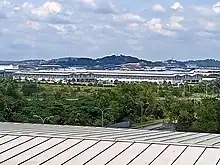
There are two maintenance depots for the Kajang Line, namely the Sungai Buloh depot and Kajang depots. The former is accessible by trains to the north of Kwasa Damansara station, while the latter is located near Sungai Jernih, where trains access the depot from Bukit Dukung instead.[65][66]
See also
Notes and references
Notes
- As of 2006, the percentage of public transport passengers was only 11%.[8]
- The Golden Triangle is Malaysia’s leading business hub, spanning areas to the north of Jalan Pudu and Jalan Changkat Thambi Dollah, west of Jalan Tun Razak and south of Jalan Ampang.[13]
- By May 2009, tenders for the LRT Kelana Jaya Line and LRT Ampang Line extension projects would be called as the designs have been finalised but there was no news on the implementation of the Kota Damansara-Cheras Line.[15]
- The main section of the line is to be extended by 12km while a branch line will extend the line by 4km.[17]
- The second line is expected to be connecting Sungai Buloh, Kepong, the city and Serdang while the third line is an orbital route.[21]
- Developers in KL city had been asked to redesign their upcoming mixed-development projects to integrate with MRT stations.[21][22]
References
- "Metro Klang Valley Kuala Lumpur - 58 driverless four-car metro trains" (PDF). Siemens Mobility.
- "Statistik Rel 2019" (PDF). Ministry of Transport (Malaysia). Archived from the original (PDF) on 22 April 2020.
- Rapid Rail to take over SBK line ops from Dec 15
- Ruban, A. (16 December 2016). "A quiet start to Malaysia's first MRT, but commuters happy". The Malay Mail Online. Retrieved 18 December 2016.
- "Najib launches Phase 2 of Sungai Buloh-Kajang MRT line". The Star Online. Retrieved 17 July 2017.
- "PM picks '17-7-2017' start date for MRT phase two". The Malay Mail. Retrieved 9 June 2017.
- "Phase 2 of Sg Buloh-Kajang MRT to be launched on July 17". Free Malaysia Today. 8 June 2017. Retrieved 9 June 2017.
- "Rail Travel Expansion". The Star. 30 August 2006. Archived from the original on 27 October 2018.
- "Kota Damansara-Cheras Rail Line Right on Track". The Star. 15 June 2008. Archived from the original on 27 October 2018.
- "Putting The Best Route Forward". The Star. 24 September 2006. Archived from the original on 27 October 2018.
- "New LRT Lines Approved". The Star. 7 July 2007. Archived from the original on 27 October 2018.
- "LRT Projects Set For Next Year". The Star. 20 April 2007. Archived from the original on 27 October 2018.
- "Golden Triangle's Renaissance". Star Property. 5 August 2016. Archived from the original on 27 October 2018. Retrieved 27 October 2018.
- "Laluan LRT Bawah Tanah Baru Di KL" (PDF) (in Malay). Utusan. 5 September 2008. Archived from the original (PDF) on 22 July 2011.
- "Govt May Invite Tenders For LRT Extension in 3 Months". TheEdgeDaily. 21 May 2009. Archived from the original on 25 May 2009.
- "RM6-7 billion for LRT extensions". TheEdgeDaily. 14 September 2009. Archived from the original on 30 October 2018.
- "Additional routes for Cheras-Kota Damansara line". TheEdgeDaily. 9 April 2010. Archived from the original on 3 March 2012. Retrieved 30 October 2018.
- "NU Sentral Set To Improve Urban Transportation, Says Najib". Bernama. 11 August 2009. Archived from the original on 23 May 2012.
- "Tenth Malaysia Plan". Archived from the original on 27 December 2012. Retrieved 20 November 2018.
- "MRT". Archived from the original on 15 May 2015. Retrieved 24 April 2015.
- "RM30b MRT plan". The New Straits Times. 8 June 2010. Archived from the original on 11 June 2010.
- Au Foong Yee (7 June 2010). "KL to have MRT system, say sources". The Edge. Archived from the original on 3 March 2012. Retrieved 20 November 2018.
- "Kajang Line". MRT Corp. Retrieved 17 July 2023.
- Loh Foon Fong (18 December 2010). "PM: Construction of RM36bil KL Mass Rapid Transit (MRT) to begin July". The Star. Archived from the original on 19 December 2010.
- Loh Foon Fong (19 December 2010). "RM36b MRT project to be broken down to nine parcels for open tender". The Star. Archived from the original on 21 December 2010.
- "Klang Valley MRT Public Display Shows Majority Want The Project" (PDF) (Press release). 7 June 2011. Archived (PDF) from the original on 20 November 2018. Retrieved 20 November 2018.
- Chooi, Clara. "Najib launches MRT project at glitzy do". Malaysian Insider. Archived from the original on 11 July 2011. Retrieved 8 July 2011.
- "Putrajaya puts MRT under new project owners". Malaysian Insider. 19 August 2011. Archived from the original on 3 September 2011. Retrieved 19 August 2011.
- transitmy. "MRT Update: MyRapidTransit launching & public viewing on 8 July 2011 at KL Convention Centre". Malaysian Transit. Archived from the original on 20 July 2012. Retrieved 11 July 2011.
- "Designing a World Class MRT". The Star. 30 May 2017. Archived from the original on 4 December 2018. Retrieved 4 December 2018.
- "TTDI Residents Against MRT System". The Star. 16 January 2011. Archived from the original on 4 December 2018. Retrieved 4 December 2018.
- "MRT project moves into active construction phase". The Star. 2 August 2012. Archived from the original on 3 August 2012. Retrieved 3 December 2018.
- Achariam, Noel (30 May 2011). "Proposed TTDI MRT station shifted". New Straits Times. Archived from the original on 5 December 2018. Retrieved 6 June 2011.
- "KL shortlists bidders for RM7b rail works". Business Times, New Straits Times. 21 October 2011. Archived from the original on 22 October 2011. Retrieved 21 October 2011.
- "IJM, AZRB win MRT jobs". The Star. 27 January 2012. Archived from the original on 3 December 2018. Retrieved 3 December 2018.
- "Twenty Eight Companies Pre-qualify For Six MRT System Work Packages" (PDF) (Press release). MRT Corp. 8 March 2012. Archived (PDF) from the original on 3 December 2018. Retrieved 3 December 2018.
- "MRT Corp Awards 4 Work Packages" (PDF) (Press release). MRT Corp. 12 July 2012. Archived (PDF) from the original on 3 December 2018. Retrieved 3 December 2018.
- "MRT Corp awards five contracts worth RM3.74bil for Sungai Buloh-Kajang line". The Star. 15 September 2012. Archived from the original on 3 December 2018. Retrieved 3 December 2018.
- "MRT Corp awards 3 system work contracts worth RM302mil". The Star. 6 February 2013. Archived from the original on 3 December 2018. Retrieved 3 December 2018.
- "Electricity Supply Agreement between MRT Corp and TNB". myMRT. 14 December 2012. Archived from the original on 4 December 2018. Retrieved 4 December 2018.
- "Klang Bus Stand to cease operations". Star Metro. Archived from the original on 21 October 2011. Retrieved 21 October 2011.
- "Sungai Buloh-Kajang MRT project wont cost over RM23bil, says CEO". The Star. 21 December 2012. Archived from the original on 3 December 2018. Retrieved 3 December 2018.
- Syed Umar Ariff (31 May 2013). "MRT project on track, says PM". New Straits Times. Archived from the original on 27 August 2013.
- "World's First Variable Density Tunnel Boring Machine Launched". myMRT. 30 May 2013. Archived from the original on 4 December 2018. Retrieved 4 December 2018.
- "First Breakthrough for MRT Project". The Star. 25 December 2013. Archived from the original on 4 December 2018. Retrieved 4 December 2018.
- "Prime Minister's First MRT Train Ride". myMRT. 1 September 2016. Archived from the original on 4 December 2018. Retrieved 4 December 2018.
- "Najib: Free MRT, feeder bus rides until Jan 16". The Star. 15 December 2016. Archived from the original on 4 December 2018. Retrieved 4 December 2018.
- Adrian Lai (18 December 2016). "MRT Corp says Rafizi got it wrong, RM21bil for both Phase 1 and 2 of SBK Line". New Straits Times. Archived from the original on 22 December 2016.
- "PM picks '17-7-2017' start date for MRT phase two | Malay Mail".
- "Government goes with Prasarana to operate Sg Buloh-Kajang MRT line". The Malaysian Insider. 16 June 2014. Archived from the original on 17 June 2014.
- "Sungai Buloh-Kajang (SBK Line)". myMRT. Archived from the original on 4 December 2018. Retrieved 4 December 2018.
- "Sungai Buloh—Kajang line - Stations". myMRT. Archived from the original on 20 November 2018. Retrieved 20 November 2018.
- "MRT stations designed to tell the story of M'sia". The Star. 3 August 2017. Archived from the original on 4 December 2018. Retrieved 4 December 2018.
- "MyRapid". www.myrapid.com.my. Retrieved 9 April 2018.
- "MRT". MyRapid. Retrieved 7 September 2021.
- "MYMRT | MRT Corp - Official webpage for the Klang Valley My Rapid Transit". Archived from the original on 18 January 2013. Retrieved 15 January 2013.
- MRT Corp (14 September 2012). "MRT CORP AWARDS RM3.474 BILLION WORTH OF CONTRACTS" (PDF) (Press release). MRT Corp. Archived (PDF) from the original on 3 July 2020. Retrieved 4 July 2020.
- "MRT Newsletter" (PDF) (Press release). MRT Corp. July–December 2014. Archived (PDF) from the original on 3 July 2020. Retrieved 4 July 2020.
- Progress Report (PDF). MRT Corp. 2012. p. 13. Archived from the original (PDF) on 4 March 2016.
- Mohamad Azmi, Kamarul Azhar (9 February 2023). "Cover Story 2: Getting the Klang Valley Rail System Back on Track". Archived from the original on 13 February 2023. Retrieved 13 February 2023.
- "TranSPOT - MRT KGL". Retrieved 25 April 2023.
- "Prasarana's Ridership". 14 January 2023. Archived from the original on 14 January 2023. Retrieved 14 January 2023.
- "Statistic of Rail Transport". Ministry of Transport (Malaysia). Archived from the original on 12 January 2023.
- "MRT needs 250,000 daily passengers to break even".
- "MRT Sungai Buloh Depot" (Map). Google Maps. Retrieved 26 October 2018.
- "MRT Sungai Jernih Depot (Satellite view)" (Map). Google Maps. Retrieved 26 October 2018.
- "Sungai Buloh Selangor". Facebook.
External links
- Mass Rapid Transit Corporation Sdn Bhd (MRT Corp)
- Prasarana Malaysia Berhad
- Suruhanjaya Pengangkutan Awam Darat (SPAD)
- MRT tunneling works by MMC-Gamuda
- Route Map
- MRT Website